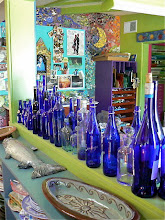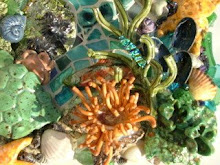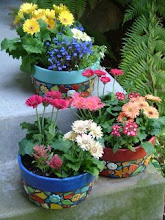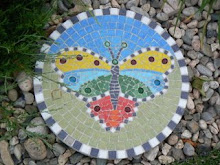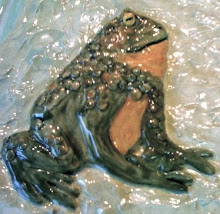 The three butterfiles in this multimedia mosaic are actually three single butterfly shaped ceramic tiles. There are no tiny individual pieces, just the illusion. Lines have been channeled in the clay while it is leather hard. After bisque firing and glaze firing, these channels will trap grout when the entire piece is grouted, leaving the butterflies to appear as though they were mosaiced from tiny pieces instead of a single piece. This is a form of ceramic Cuerda Seca technique. If you look closely at the bottom butterfly, you will see that I forgot to channel the large portion of its left wing. Notice how it looks different than the right, as if it were one piece instead of two.
The three butterfiles in this multimedia mosaic are actually three single butterfly shaped ceramic tiles. There are no tiny individual pieces, just the illusion. Lines have been channeled in the clay while it is leather hard. After bisque firing and glaze firing, these channels will trap grout when the entire piece is grouted, leaving the butterflies to appear as though they were mosaiced from tiny pieces instead of a single piece. This is a form of ceramic Cuerda Seca technique. If you look closely at the bottom butterfly, you will see that I forgot to channel the large portion of its left wing. Notice how it looks different than the right, as if it were one piece instead of two.About me
Monday, July 21, 2008
Ceramic Cuerda Seca Technique
 The three butterfiles in this multimedia mosaic are actually three single butterfly shaped ceramic tiles. There are no tiny individual pieces, just the illusion. Lines have been channeled in the clay while it is leather hard. After bisque firing and glaze firing, these channels will trap grout when the entire piece is grouted, leaving the butterflies to appear as though they were mosaiced from tiny pieces instead of a single piece. This is a form of ceramic Cuerda Seca technique. If you look closely at the bottom butterfly, you will see that I forgot to channel the large portion of its left wing. Notice how it looks different than the right, as if it were one piece instead of two.
The three butterfiles in this multimedia mosaic are actually three single butterfly shaped ceramic tiles. There are no tiny individual pieces, just the illusion. Lines have been channeled in the clay while it is leather hard. After bisque firing and glaze firing, these channels will trap grout when the entire piece is grouted, leaving the butterflies to appear as though they were mosaiced from tiny pieces instead of a single piece. This is a form of ceramic Cuerda Seca technique. If you look closely at the bottom butterfly, you will see that I forgot to channel the large portion of its left wing. Notice how it looks different than the right, as if it were one piece instead of two.Thursday, July 10, 2008
New Glazes
While Jan and I have been busy studying Sculpture at UC Berkeley Art Studio Wednesday nights, we've also been experimenting with some new glazes. Here are four of Jan's tiles, freshly painted on greenware using low fire translucent underglazes which have been packaged to look like watercolors, and be used in a similar fashion. Once painted on the leather-hard clay they are ready to be bisqued in the kiln at Cone 04. 


 And my attempt, using Amaco Velvet underglazes combined with Jan's watercolor glazes in the yellow center and the leaves.
And my attempt, using Amaco Velvet underglazes combined with Jan's watercolor glazes in the yellow center and the leaves.  After these are fired, they will require a clear glaze to be painted over the entire tile and then re- fired to Cone 05. We have no idea how they will really look until the moment we lift the lid. That's the exciting part of ceramics, opening the kiln and seeing what happened during the second firing!
After these are fired, they will require a clear glaze to be painted over the entire tile and then re- fired to Cone 05. We have no idea how they will really look until the moment we lift the lid. That's the exciting part of ceramics, opening the kiln and seeing what happened during the second firing!
 A few 3-D hand sculpted tiles loaded in the kiln and ready for bisque 04 firing. The fish tile and the frog on the lily pad are made with slip glazes, which we've been exposed to for the first time in our sculpture class--something new for us, painting with colored clay. Lots of experimenting in progress. In order to appear shiny after bisque firing, these tiles will require a clear glaze and a second firing at Cone 05 or Cone 5, depending on the initial glaze used.
A few 3-D hand sculpted tiles loaded in the kiln and ready for bisque 04 firing. The fish tile and the frog on the lily pad are made with slip glazes, which we've been exposed to for the first time in our sculpture class--something new for us, painting with colored clay. Lots of experimenting in progress. In order to appear shiny after bisque firing, these tiles will require a clear glaze and a second firing at Cone 05 or Cone 5, depending on the initial glaze used.



 And my attempt, using Amaco Velvet underglazes combined with Jan's watercolor glazes in the yellow center and the leaves.
And my attempt, using Amaco Velvet underglazes combined with Jan's watercolor glazes in the yellow center and the leaves.  After these are fired, they will require a clear glaze to be painted over the entire tile and then re- fired to Cone 05. We have no idea how they will really look until the moment we lift the lid. That's the exciting part of ceramics, opening the kiln and seeing what happened during the second firing!
After these are fired, they will require a clear glaze to be painted over the entire tile and then re- fired to Cone 05. We have no idea how they will really look until the moment we lift the lid. That's the exciting part of ceramics, opening the kiln and seeing what happened during the second firing! A few 3-D hand sculpted tiles loaded in the kiln and ready for bisque 04 firing. The fish tile and the frog on the lily pad are made with slip glazes, which we've been exposed to for the first time in our sculpture class--something new for us, painting with colored clay. Lots of experimenting in progress. In order to appear shiny after bisque firing, these tiles will require a clear glaze and a second firing at Cone 05 or Cone 5, depending on the initial glaze used.
A few 3-D hand sculpted tiles loaded in the kiln and ready for bisque 04 firing. The fish tile and the frog on the lily pad are made with slip glazes, which we've been exposed to for the first time in our sculpture class--something new for us, painting with colored clay. Lots of experimenting in progress. In order to appear shiny after bisque firing, these tiles will require a clear glaze and a second firing at Cone 05 or Cone 5, depending on the initial glaze used.
Subscribe to:
Posts (Atom)
